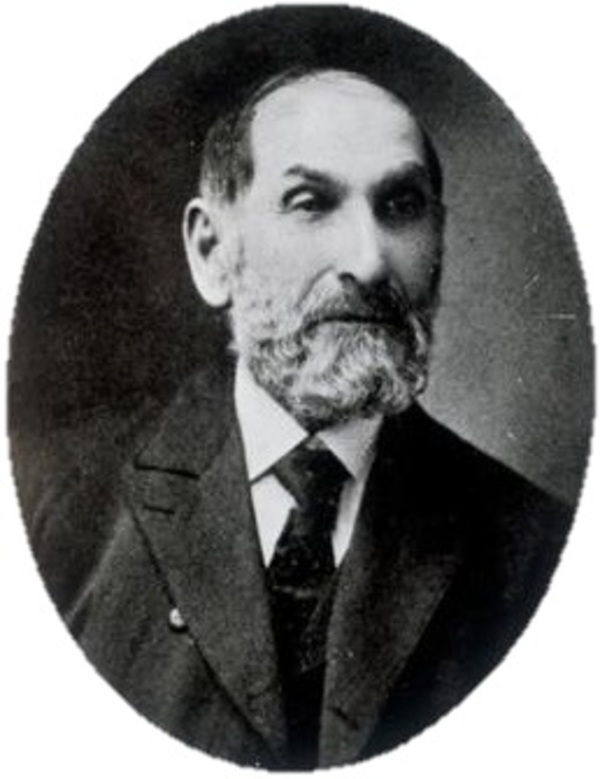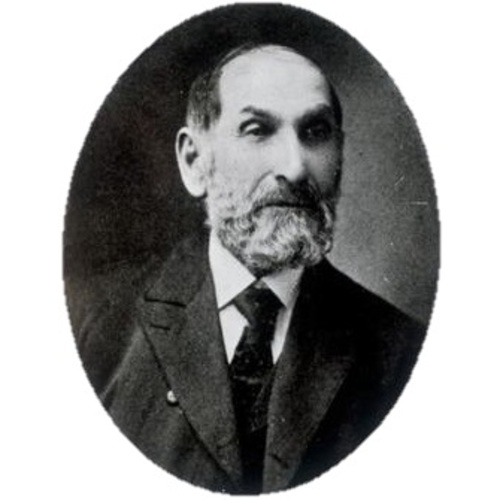
Source: Link
SHANTZ, JACOB YOST, farmer, businessman, office holder, author, and promoter of Mennonite settlement; b. 2 May 1822 in Ebytown (Kitchener), Upper Canada, eighth of the ten children of Jacob Shantz, a farmer and sawmill owner, and Mary Yost; m. first 2 May 1843 Barbara Biehn (d. 1853), and they had three daughters and two sons; m. secondly 6 Dec. 1853 Nancy Anna Brubacher (d. 1870), and they had seven children; m. thirdly 1 Oct. 1871 Sarah Shuh (d. 1893); d. 28 Oct. 1909 in Berlin (Kitchener).
Jacob Yost Shantz grew up in Ebytown, later known as Berlin, where his parents, Mennonites from Pennsylvania, had purchased land in 1810 [see Benjamin Eby*]. On his 21st birthday he married his cousin Barbara Biehn and not long afterwards they took over his parents’ farm. Shantz then became manager of his father’s sawmill, began to buy and sell real estate, and invested in other local business ventures. His interests extended to education and public service: he acted as a school trustee and held several minor local posts, such as fence inspector, road overseer, and village tax collector. He was also an early supporter of the temperance movement.
Shantz soon diversified his business interests. He found a variety of markets for the wood from his sawmill and the woodlots he acquired in the early 1850s, constructing wooden sidewalks in Berlin, providing fuel for the Grand Trunk Railway, and supplying building materials to German immigrants. He took a major step as an entrepreneur in 1861 when he bought a property on the corner of King and Foundry (Ontario) streets, Berlin, and constructed the Canadian Block, a three-storey commercial building. As a contractor, he became involved in numerous projects, one of the most important of which was the erection of the Berlin market-house in 1869. Early the following year he built a button factory for Emil Vogelsang and his partner, John Jacob Woelfle. Seven months later Woelfle sold his interests in the factory to Shantz, who quickly gained prominence as a manufacturer. In 1875 the partnership between Vogelsang and Shantz was terminated. The Dominion Button Works became Shantz’s; his sons would assist him in managing the company, which by 1880 employed over 140 workers. Early in 1873 Shantz had also formed a partnership to manufacture felt. Shantz and Feick lasted only two years, but Shantz went on to form other partnerships for his felt business and continued in it until about 1880.
In 1872 Shantz had been asked by the Canadian government to travel to western Canada with a Mennonite from southern Russia, Bernhard Warkentin, who was considering immigration to North America. The government mistakenly thought that Warkentin was a member of an official delegation; it is not entirely clear why Shantz was selected to accompany him. After visiting Manitoba with him Shantz sent a report of his journey to the government. Favourably impressed, immigration officials asked that he prepare a more detailed account for publication. Narrative of a journey to Manitoba was translated into a number of languages and became an important item in the promotion of European immigration to the west. Meanwhile, the federal government had assigned Wilhelm Hespeler* to visit Mennonite colonies in Russia to see if further contacts might encourage prospective immigrants to choose Canada rather than the United States. In the spring of 1873 six Mennonite colonies sent two delegates each to investigate opportunities in North America. Shantz was invited to accompany Hespeler and the group to Manitoba, and he took them through the regions southeast and west of Winnipeg.
When many Mennonites decided to immigrate [see Gerhard Wiebe*], Shantz was asked to serve as Canadian director of the movement, to assist with transportation and other arrangements, and to see that the immigrants arrived safely at their destination. He needed to raise a considerable amount of money to help defray the expenses of the approximately 7,000 settlers who were to arrive in Manitoba during the next six years. Many were unable to sell their property in Russia or lacked the means to pay for their transportation and purchase necessary supplies. Shantz served as secretary-treasurer of a committee organized in 1874 to receive and administer funds lent by Mennonites living in Ontario. The following year the committee successfully requested from the federal government a loan of $100,000 and a subsidy of $70,000 for transportation. Shantz and other Ontario Mennonites acted as guarantors for these and additional loans. Over the years Shantz would travel frequently between Ontario and Manitoba, to provide assistance to the immigrants, arrange repayment of the loans, and, when needed, obtain more funds. In return for his services he received a number of land grants in the “reserves” which had been set aside for the Mennonites to the east and west of the Red River. Two communities, Schanzenfeld and Schanzenberg, were named in his honour.
While Shantz was engaged in immigration activities, the Dominion Button Works had continued to expand. In 1884 it employed 300 workers at Berlin and by 1886 it opened a branch plant in Buffalo, N.Y. Shantz nevertheless experienced severe financial difficulties in the mid 1880s and was forced to sell numerous properties in order to clear his debts and those of Jacob Y. Shantz and Sons, which operated the works. In June 1891 the company was reorganized and Shantz retired from the business.
Shantz saw another opportunity, however, again in western Canada. In July 1892 he announced his intention to start a colony there. He located suitable land at a site called Didsbury (Alta), about 50 miles north of Calgary. The following summer he canvassed Mennonites in Ontario and the United States and succeeded in persuading 44 families to take up homesteads in the northwest. A major exodus from the region of Berlin took place in the spring of 1894. Among the group which left were two of Shantz’s children and their families. Shantz would journey west to visit his children in the Didsbury area until he was 85. He is said to have made a total of 27 trips from Ontario to the west in connection with his interests there.
Shantz had long been a active member of the Mennonite church in Berlin. In 1875 he joined a reform group called the United Mennonites, later known as the Mennonite Brethren in Christ. Shantz moved again in 1898, this time to the Church of Christ, Scientist. He remained active in the First Church of Christ, Scientist, in Berlin for several years until poor health restricted his movements.
Jacob Yost Shantz died in 1909, preceded by three of his twelve children, his three wives, and all his brothers and sisters. He is remembered for his considerable business expertise and the enormous energies he invested in the various enterprises he had fostered, above all in the immigration of thousands of Mennonites to western Canada. In addition to a modest estate, he left a spiritual heritage, that of a religious man, wanting first and foremost to serve God and his fellow man. In the estimation of many who knew him, he had done both well.
[Jacob Yost Shantz is the author of Narrative of a journey to Manitoba, together with an abstract of the Dominion Lands Act; and an extract from the government pamphlet on Manitoba (Ottawa, 1873), translated into French as Relation d’un voyage à Manitoba, accompagnée d’une analyse de l’Acte concernant les terres de la Puissance et d’un extrait du pamphlet publié par le gouvernement a[u] sujet de Manitoba (Ottawa, 1873).
The first partial life story of Shantz appeared in Melvin Gingerich, “Jacob Y. Shantz, 1822–1909, promoter of the Mennonite settlements in Manitoba,” Mennonite Quarterly Rev. (Goshen, Ind.), 24: 230–47. His role in the immigration of Mennonites to Manitoba has been thoroughly documented in two articles by Ernst Correll in the Mennonite Quarterly Rev., “Mennonite immigration into Manitoba: sources and documents, 1872, 1873” and “Mennonite loan in the Canadian parliament,” 11 (1937): 196–227, 267–83 and 20 (1946): 255–75, respectively, as well as in three collections of documents which he edited for the same journal: “Canadian agricultural records on Mennonite settlements, 1875–77,” 21 (1947): 34–46; “Mennonite immigration into Manitoba: documents and sources, 1873–1874,” 22 (1948): 43–57; and “Sources on the Mennonite immigration from Russia in the 1870’s,” intro. H. S. Bender, 24 (1950): 329–52. The definitive biography is now S. J. Steiner, Vicarious pioneer: the life of Jacob Y. Shantz (Winnipeg, 1988). l.k.]
Cite This Article
Lawrence Klippenstein, “SHANTZ, JACOB YOST,” in Dictionary of Canadian Biography, vol. 13, University of Toronto/Université Laval, 2003–, accessed January 12, 2026, https://www.biographi.ca/en/bio/shantz_jacob_yost_13E.html.
The citation above shows the format for footnotes and endnotes according to the Chicago manual of style (16th edition). Information to be used in other citation formats:
| Permalink: | https://www.biographi.ca/en/bio/shantz_jacob_yost_13E.html |
| Author of Article: | Lawrence Klippenstein |
| Title of Article: | SHANTZ, JACOB YOST |
| Publication Name: | Dictionary of Canadian Biography, vol. 13 |
| Publisher: | University of Toronto/Université Laval |
| Year of publication: | 1994 |
| Year of revision: | 1994 |
| Access Date: | January 12, 2026 |



